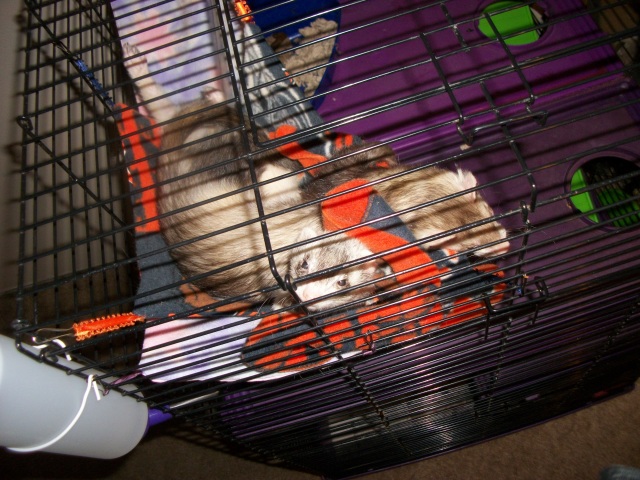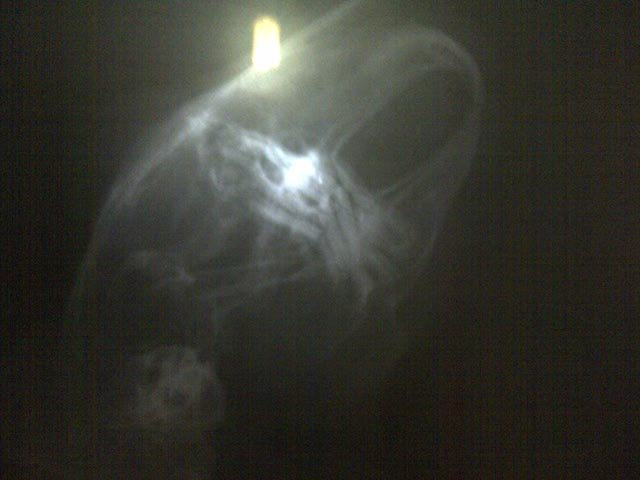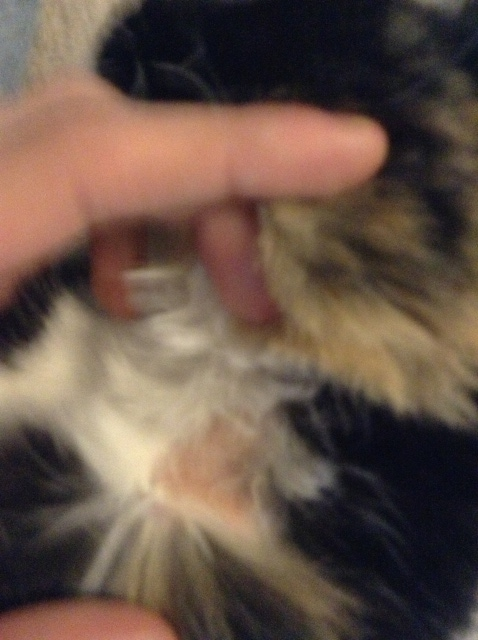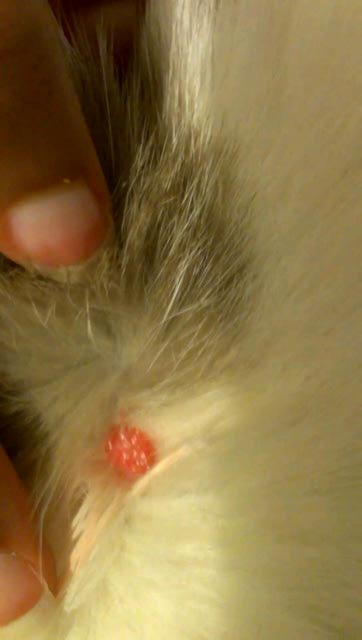QuestionI am planning on getting a cocker spaniel puppy this Feb. The lady I am getting him from just informed me that his mom was taken to the vet for discomfort in her back legs. The X-ray showed her hips were fine but a bone in her spine had grown the wrong way.
On one side of her bottom lumbar the bone points downward instead of upward.
Her vet feels it is a birth defect and possibly genetic.
Have you ever heard of such a thing and do you know if the possibility of being genetic is there?
She (the mom) has been on anti-inflammatorys and seems to be respnding well to them.
Thanks for your time
Shelly
AnswerI have not heard of such a condition of the spine bone growing the wrong way. Older dogs often develop spondylosis (below is more information) and typically it does not cause much problem as often it is an incidental problem. If indeed a birth defect, or genetic predisposition, then I would be concerned about purchasing a puppy. Find out if the mom had any trauma or problems giving birth or has been tested positive for Lyme Disease. Other things to ask the breeder are questions relating to temperament of the parents as well as any history of skin or ear problems, thyroid or cushing's disese or urinary tract problems in the line of dogs as these are things you want to know before buying a puppy.
Spondylosis Deformans
by Fred Lanting
Spondylosis deformans is a condition in which bridges are formed along the ventral (bottom) parts of the vertebrae. It has been diagnosed in man, domestic cats (68%, yet no symptoms!), bulls, and even whales as well as in dogs. The term "spondylitis" literally means "an inflammation of the spine", especially the bone, and spondylosis is sometimes used as a synonym as well as for describing types of ankylosis. One of these types is a bone proliferation, usually on the ventral surfaces of adjacent vertebrae, producing a bridge from one to the other. This condition is best known as spondylosis deformans. There is no spinal cord compression, but the spine is immobilized in that location. If the condition continues to spread, there may be several such bridges, "welding" a series of vertebrae into an inflexible backbone. It is seen fairly easily via lateral radiography. Because of different degrees seen in different breeds, I believe there to be more than one genetic determinant for this disorder, though nutrition may play a modifying role. I know full well the familial line in a significant portion of American German Shepherd Dogs with this problem, but there are some "German" lines with it, too. Pain may come from encirclement or pressure on nerve roots leading out from the cord to peripheral nerves, although such discomfort might be from concurrent arthritis, cauda equina syndrome, or other problems. As in Wobbler Syndrome, much growth of osteophytes can occur, and may be part of the reason some dogs have pain, but generally the animal does not appear to be suffering.
It is not completely clear how this disorder progresses, but it may start with a breakdown of Sharpey's fibers, which are the fibers making up the annulus or outer portion of the intervertebral disks. Subsequently, inner disk material protrudes, stretching the longitudinal ligament, and promoting the appearance of osteophytes which grow out from the vertebral bodies in such a way that one cannot tell where the original bone ends and the osteophytic growth begins. Before that happens, though, separate ossification centers can be seen forming a few millimeters from the vertebral bodies; they later fuse and grow toward the adjacent vertebral segment. Eventually, and depending on breed and family history, the disk spaces between particular segments are bridged. True ankylosis (complete fusion into a continuous bony bridge between vertebrae) is far less common than the near-junction of these osteophytes.
Very seldom do the osteophytes grow upward or in such a way as to pinch the spinal cord or otherwise cause neurological signs, so spondylosis deformans might be considered a relatively benign disorder when compared with HD, elbow dysplasias, wobbler syndrome, etc.
Many affected dogs live satisfactory lives, though somewhat limited in flexibility and range of motion. Fortunately, by the time spondylosis deformans becomes noticeable in clinical signs, the dog may be considered "retired" from his duties of running around, jumping, and doing the other things expected of a youngster. In some individuals, it will get worse suddenly rather than continue in a gradual worsening. Possibly, trauma may bring fracture of the bridge created in the development of spondylosis, which crack may spread to the arch and body, thus pinching the cord.
Often, spondylosis will be discovered on radiographs incidentally while the vet is looking for something else, such as a cause for lameness. In some of these cases, he may be tempted to make his diagnosis right then, and not to look further for the actual main cause, which may include HD, osteochondrosis in other joints, tumors, and others. Osteoarthritis of the spine (inflammation of the joints between vertebrae) is not the same disorder, nor is true spondylitis (an inflammation of the vertebrae themselves, brought on by either trauma or infection). Remember that "-itis" means inflammation, and spondylosis deformans is a non-inflammatory degenerative disease.
An intervertebral inflammation resulting in fusion of the vertebrae has been seen in humans and is known as ankylosing spondylitis. It is related to both adult and juvenile rheumatoid arthritis, and the similarity to spondylosis deformans in the dog (minus the inflammation) makes me wonder if there is a common or similar genetic defect in the "immune systems" of man and beast. Although it has been misnamed ankylosing spondylitis in the past, spondylosis deformans in the canine is not that disorder, exactly.459 Senile ankylosing hyperostosis is a syndrome in humans that is considered to be a variation of osteoarthritis140 characterized by large osteophytes, bridging between and on the anterolateral (front and side) surfaces of the vertebral bodies. In man, it appears mainly in males over 50 years of age, giving symptoms of minor to moderate back pain, stiffness, and lack of flexibility. Bone spurs and ossification in tendons and ligaments are common.
Even intervertebral osteochondrosis may be a separate disorder; although also a result of disk degeneration, it is characterized by reduced disk height and vertebral end-plate sclerosis, not seen in spondylosis deformans.469
The genetic transmission of the tendency to develop this disease is obvious to anyone who has watched it appear in offspring of certain dogs, generation after generation. But exactly how (the etiology) is not as sure. Perhaps there is an inherited weakness in how a dog's vertebrae respond to or withstand repeated microtraumas; perhaps in some lines, the blood vessels that serve the outer layers of the disks regress and disappear faster than the normal or expected three or four years. It seems to be a fairly natural consequence of aging, as 75% of dogs in some breeds are affected to some degree by 9 years, and half by 6 years.459 On the other hand, some work has indicated that spondylosis deformans is more a disease of middle age. Breed and family variables make the incidence figures vary tremendously. It became a very noticeable disorder in the German Shepherd Dog when, for a while, 90% of the "show" German Shepherd Dogs in the USA were allegedly descended from one very popular late-1960s American Grand Victor (estimate based on a pedigree study reported in a GSD magazine several years ago) who had and passed along this disease in a severe form.
A couple of other miscellaneous thoughts about spondylosis: Regarding the effect or influence of environment, small trauma has already been mentioned as a possible factor, but with little evidence. It is suspected that bulls on high-calcium diets may have increased susceptibility.34 Males seem more at risk than females.

 Blind Ferret?
QuestionQUESTION: How can you tell if a ferret is blind
Blind Ferret?
QuestionQUESTION: How can you tell if a ferret is blind
 Is my Husky Puppy underweight?
Question
Maxx- My Husky Puppy
I have a 11 1/2 weeks (he
Is my Husky Puppy underweight?
Question
Maxx- My Husky Puppy
I have a 11 1/2 weeks (he
 inquiry..my bunny keeps drolling n grinding his teeth
Question
dental xray xray
Dear Jana,
Hai..
inquiry..my bunny keeps drolling n grinding his teeth
Question
dental xray xray
Dear Jana,
Hai..
 Cat Scabs and Hair Loss
Question
Scab Scab Again
My family just ad
Cat Scabs and Hair Loss
Question
Scab Scab Again
My family just ad
 Red sore on my cat
Question
Cat Sore
Hi. I recently noticed a
Red sore on my cat
Question
Cat Sore
Hi. I recently noticed a